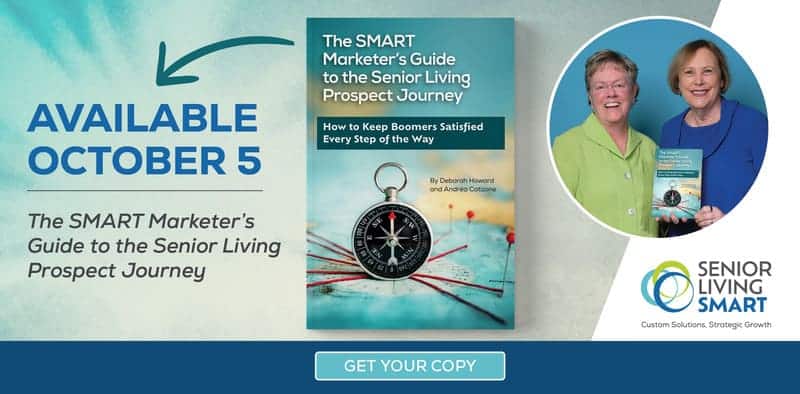Senior Living Social Media Marketing: Storytelling Tips

Humans are suckers for a good story, full stop. We love telling stories. We love listening to stories. And thanks to social media, there’s no shortage of ways to consume stories, either.
For the casual scroller, encountering interesting stories on social media can be a fun way to while away the hours. For savvy businesses, however, sharing memorable stories can increase engagement, brand recognition, and even sales.
Consider these compelling storytelling stats:
- Search Engine Watch reports that storytelling can increase content marketing conversion rates by 30%.
- Marketing Profs cites a study by cognitive psychologist Jerome Bruner suggesting that a fact wrapped in a story is 22 times more memorable.
- Go-Globe notes in this infographic on storytelling that most consumers (75%) want brands to use storytelling.
So, let’s discuss the power of storytelling in senior living social media marketing—and some tips for creating truly memorable stories on three of the biggies: Facebook, Instagram, and LinkedIn.
Along with YouTube, Facebook is still the granddaddy of all social media platforms, with over two billion active daily users globally. According to Hootsuite, it’s also the most used platform in the U.S.
This makes Facebook an ideal platform for senior living communities to connect with prospects, current residents, and their families.
Facebook Storytelling Tips for Senior Living
Your residents are an excellent source of compelling stories, so turn to them for ideas. Even better, their stories won’t be the same ones people see on a competitor’s social media accounts.
Here’s how to use their stories on Facebook:
- New resident spotlights. By highlighting a new resident, you’ll create a warm and fuzzy feeling for the resident and their family. You’ll also show prospects how you celebrate residents.
- Holidays. Here are some examples. For Thanksgiving, ask residents to share their favorite family traditions. On Halloween, ask residents if they’ve ever encountered a ghost or haunted house. You get the idea. Consider venturing beyond traditional holidays and focus on creating stories around things like National Hot Dog Day or National Ice Cream Month in July.
- Day-in-the-life stories. Follow a resident around for a day in your community and highlight the happy moments.
- Timelapse videos of events, like decorating the Christmas tree or how the gardens change from spring to fall.
Regarding story length, remember that no one expects a novel or movie. Shorter posts typically get better engagement on Facebook.
What do we mean by short? HubSpot says 40 characters or fewer. If you’re about to say it’s impossible to share a good story at that length, consider the famous six-word short story attributed to Hemingway: For sale: Baby shoes, never worn.
BOOM. That little story, which weighs in at 33 characters, delivers one heck of an emotional punch. Now, we’re not suggesting that you must stay under 40 characters. But you should aim for no more than a couple of sentences. Do your best to keep your post under 200 characters (at which point the text gets cut off, and people need to click to “see more”).
How can you keep it short and sweet while still delivering a compelling story? Here are some strategies.
Provide a super-short story, like Hemingway’s, but illustrate it with a pic or two.
- EXAMPLE: Meet Mary. She loves quilting, cats, and a dry martini with three olives. Cheers!
o Make sure you include a picture of Mary holding up her martini.
Offer a cliffhanger that entices people to click into a longer piece of content.
- EXAMPLE: Meet Mary. She loves quilting, cats, and a special libation that she swears has kept her 87 years young. Find out what it is in our latest Resident Spotlight.
o Link to a narrative about Mary on your website.
Let videos tell the stories.
- EXAMPLE: Mary, our newest resident, reveals the drink she can’t live without.
o Include a short video where Mary is toasting with her friends.
Videos are incredibly helpful in telling stories. Plus, videos boost engagement. (People spend half their time on Facebook watching videos.) Videos don’t need to be super long (think one to two minutes max), and they don’t need to be professionally shot, either.
Encourage residents and staff to keep their smartphones handy and share raw footage with the marketing department (here’s how to foster and reward this behavior). With an intuitive editing app like InShot, you can edit the raw footage into a compelling video.
Instagram caters to a much younger demographic than Facebook. According to Hootsuite, 85% of IG users are under 45. You might be thinking, why bother? Well, nearly 16% of Instagram users are between 35 and 44, and 8% are between 45 and 54. Many of those users have aging parents and will likely be involved in the decision-making process when Mom and Dad consider moving to senior living.
The bottom line: Instagram is still an excellent place to share content, as long as you remember that you’ll most likely be talking to adult children rather than seniors themselves.
Instagram Storytelling Tips for Senior Living
So the question becomes, how do you engage this younger demographic, one that might influence their parents and grandparents?
We recommend turning to time-tested hashtags on Instagram—and reinventing them.
For example, hashtags like #food (and its various synonyms) are among the most popular hashtags on Instagram. Food is also among the most common questions communities receive from prospects and their families. Plus, it’s one of the topics communities like to promote as a differentiator.
You see where we’re going with this, right?
Use #food as the starting point for your storytelling. No, we’re not suggesting you show shots of what’s for dinner and call it a day.
Brainstorm all the stories around food in your community. Questions to ask yourself:
- What’s your chef’s story? Conduct a video interview with them. You could also do a timelapse video of the chef and their team preparing dinner. Or record another video of them doing something special, like decorating a cake for a resident’s birthday or making one of the most popular dishes in the community. And then—this is important—share the recipe in the caption.
- Does your community have a vegetable garden? Do the residents help with gardening? What’s grown, and what dishes are made from the harvest? Take a bunch of pics and include an engaging caption.
- Where are veggies and meats sourced from? If there’s an interesting story—fishmonger, local butcher, farm-to-table approach—highlight it.
- What are residents’ favorite meals for breakfast, lunch, and dinner? Do a breakfast montage where you shoot a video of favorite meals interspersed with quick snippets of residents saying what they love about that meal.
- Do you host pasta parties, brunches, ice cream sundae bars, etc.? Lively reels with fun captions are always crowd-pleasers on IG.
- How about celebrations? Record a video highlighting how the dining staff works with a resident and their family for special occasions—wedding anniversaries, birthday parties, Mother’s Day brunches, and so forth.
Remember, no other community has your chef, your recipes, or your dining staff. By focusing on a popular hashtag like #food, you’ll gain traction (over time), but you’ll also be able to stand out—in a good way—from the competition.
Note: We’re not suggesting you can’t have content highlighting other areas of your community. But if you create stories around the food in your community, you’ll capture people’s attention and boost engagement. And we’re not just talking about more likes, either. People often share and save food-related content, especially food demonstration videos and recipes.
Here are some more tips for this approach . . .
- Don’t forget the captions. If you need inspo, check out how local restaurants and hotels approach writing fun captions on Instagram.
- Don’t forget to repurpose your videos. You can use the videos on other platforms. Share them on TikTok and YouTube as well.
- If your competitors join the #food action, that’s OK. Again, all communities will have different food tales to tell.
Your community is only as good as your employees. The most successful communities usually have happy, loyal people who enjoy their profession and love working for your senior living community. If you have a rotating door of staff members coming and going, everyone will feel it (and not in a good way), including residents, families, and fellow employees.
While fixing employment challenges is beyond marketing’s purview, the marketing department can still help attract the right people to open roles within the community. This is where LinkedIn comes in.
LinkedIn Storytelling Tips for Senior Living
The stories you share on LinkedIn can provide a glimpse into what it’s like to work in your community. To get started, revisit your community’s mission and value statements. From there, share content that shows how employees embody these values.
For example, if compassionate care is one of your community’s values—and not just for residents but also employees—you could share the story about an employee who recently had a baby and the amount of parental leave they were given, the flexible “easing” back into their work schedule, and the adorable gift basket the community delivered to the new parent and baby.
Of course, everything you share has to be true, but you get the idea. By sharing a true story demonstrating your community’s values and how they affect employees, you’re showing prospective employees what they can expect. Showing instead of “telling” is the hallmark of good storytelling.
More storytelling ideas for LinkedIn:
- Employee Spotlight. Just as you have resident spotlights, you can record short videos or write up short narratives on employees.
- Employee Testimonials: Share written or video testimonials from employees about why they love working in your community. These personal stories can provide insight into your community’s positive work culture and supportive environment.
- Professional Development and Training: Highlight stories of employees who have benefited from ongoing training and professional development opportunities. Share how these programs have helped them advance their careers and improve their skills, reflecting your community’s commitment to continuous learning.
- Team Achievements: Showcase team achievements and collaborative projects that have significantly affected the community. This could include successful events, innovative programs, or any initiatives that highlight the teamwork and dedication of your staff.
Bottom line: Make sure you’re including compelling stories in your senior living social media marketing.
By tailoring your storytelling approach to fit each platform’s unique features and audiences, you can maximize engagement and highlight the vibrant life within your senior living community. These tips will help you create compelling content that resonates with current residents, prospective residents, and their families.
Here’s more helpful content on social media marketing in senior living:




